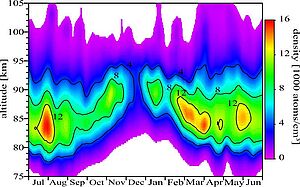Metal layers and trace gases
Investigations of trace gases in the middle atmosphere contribute significantly to our understanding of the chemistry and dynamics of this altitude region. Absorption of solar radiation and chemical heat release (or input) plays an important role in the energy budget of the middle atmosphere. Some trace gases like metal atoms are comparatively easy to examine by ground-based lidars, and therefore they provide an important "tool" for soundings of the mesopause region. E.g., the Doppler broadening of the resonance backscatter of metal atoms is a direct measure of neutral temperature at these altitudes (~85-105 km). Also the temporal changes of metal concentration provide important information about tides and gravity waves in the atmosphere, sporadic electron layers, evaporation of cosmic dust etc.

Metal soundings are performed since many years at Kühlungsborn. Recently, we were able to quantify for the first time the abundance of Ni atoms in the mesopause region. This metal was so far only weakly detected at another site. Li measurements have been resumed after a hiatus of more than 40 years and are intended to help understand anthropogenic influences on the middle atmosphere. Lithium is released during satellite re-entry and at the same time has a very low natural density. Additionally, the mobile K lidar (until 2004) and Fe lidar (since 2004) are making observations of the respective species at different sites globally.
In the last few years regular soundings of atmospheric water vapour by means of the microwave spectrometer MISI have been established at Kühlungsborn. The vertical distribution of water vapour and its temporal changes on scales of hours, days, or months provide an important data set for comparison with chemical transport modelling and for local observations of Noctilucent Clouds (NLC) above Kühlungsborn.
Selected publications
- Gerding M., R. Wing, W. Feng. J. M. C. Plane, G. Baumgarten, New Li lidar observations and model simulation: A window to anthropogenic signatures, Geophys. Res. Lett., October 2025, accepted. Preprint in ESS OpenArchive (DOI: 10.22541/essoar.175743022.28452149/v2)
- Gerding, M., S. Daly, and J.M.C. Plane, Lidar soundings of the mesospheric nickel layer using Ni(3F) and Ni(3D) transitions, Geophys. Res. Lett., 46, 408-415, https://doi.org/10.1029/2018GL080701, 2019
- J. Lautenbach, J. Höffner, F.-J. Lübken, M. Kopp und M. Gerding, Ten-year climatology of potassium number density at 54°N, 12°E, J. Atmos. Solar-Terr. Phys., 162, 172-177, doi:10.1016/j.jastp.2017.06.010, 2017












